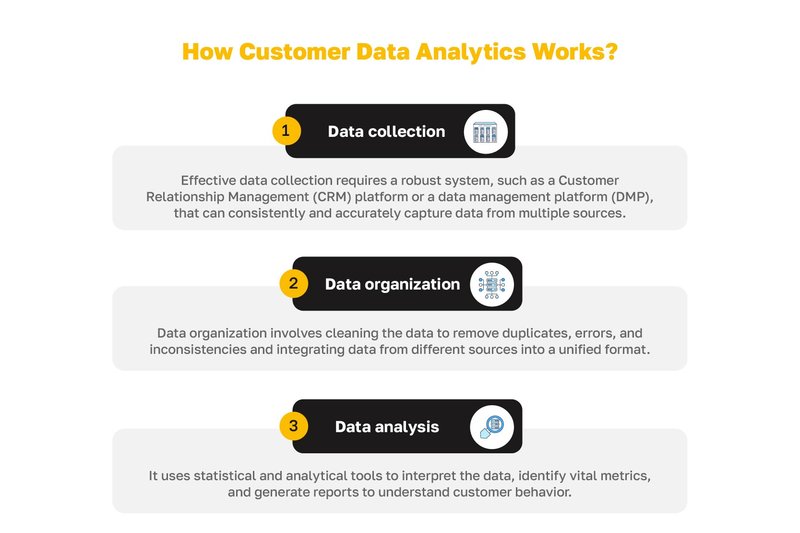Are you looking for a powerful way to drive business growth and improve customer experiences? Have you struggled with making sense of large amounts of customer data? Do you feel frustrated when you know valuable insights are hidden in your data and have no idea how to uncover and use them effectively?
We’ve all been there before, not understanding how to turn data into actionable insights and improve the customer journey. That’s why, with our extensive experience leveraging data for smarter strategic decisions, WillDom is here to guide you on using customer data analysis for business growth.
What Is Data Customer Analytics?
Customer data analytics involves collecting, organizing, and analyzing customer data to gain insights into their behavior, preferences, and needs. This data can come from various sources, including purchase history, website interactions, social media activity, etc. Businesses can identify patterns that inform marketing strategies and other business decisions by analyzing this data.
Example
A subscription-based streaming service can leverage customer data analytics to enhance user experience and drive subscriber growth. The service gains insights into content preferences by collecting data on viewing habits, such as the genres, shows, and movies that users frequently watch.
Additionally, they analyze interaction data, including viewing times and device usage, to understand when and how subscribers engage with their platform. This information allows the company to create personalized content recommendations, tailor marketing campaigns to individual preferences, and schedule releases at optimal times.
By continuously analyzing this data, they can also identify trends in subscriber behavior, predict potential churn, and implement targeted retention strategies. So, ultimately, customer data analytics improve satisfaction and increase retention rates for the subscription-based streaming service.
Why Does Customer Analytics Matter?
Customer analytics matter because they provide actionable insights that can lead to significant business growth. They allow companies to create personalized marketing strategies, enhance customer experiences, and develop products that resonate with their target audience. Customer analytics also help identify at-risk clients, enabling the creation of proactive retention strategies.
How Customer Data Analytics Works
Understanding how customer data analytics works is crucial for effectively leveraging its benefits. The process typically involves three steps that transform raw data into actionable insights, guiding businesses toward strategic decisions and growth.
Here’s a detailed look at how customer data analytics works:

Step 1: Data collection
The first step in customer data analytics is data collection. Effective data collection requires a robust system, such as a Customer Relationship Management (CRM) platform or a data management platform (DMP), that can consistently and accurately capture data from multiple sources. These sources may include purchase histories, customer feedback, website interactions, and social media activities.
Step 2: Data organization
Once data is collected, it needs to be organized to make it usable. Data organization involves cleaning the data to remove duplicates, errors, and inconsistencies and integrating data from different sources into a unified format. This step may also include categorizing data into segments based on demographics, behavior, or other relevant criteria.
Step 3: Data analysis
The final step is data analysis. It uses statistical and analytical tools to interpret the data, identify vital metrics, and generate reports to understand customer behavior. Companies use descriptive analytics to summarize past data, predictive analytics to forecast future trends, and prescriptive analytics to provide recommendations for decision-making.

How to Apply Customer Data Analytics in Business Decisions
Customer data analytics can be applied in various ways. Businesses can create more effective strategies and optimize their operations by leveraging the insights gained from data analysis.
Here are five essential ways to apply customer data analytics in your business decisions:
#1 – Creating personalized strategies
By analyzing customer preferences, behaviors, and purchase histories, companies can tailor their messages and offers to meet the needs and interests of their target audience. Personalized strategies can include customized email campaigns, targeted advertising, and personalized website experiences, all of which enhance consumer engagement and increase conversion rates.
#2 – Improving customer targeting and segmentation
Customer data analytics helps businesses segment their audience based on shared characteristics such as demographics, behavior, and psychographics. By understanding each segment’s unique needs, companies can create targeted campaigns that address specific consumer pain points and preferences, leading to higher engagement and better results.
#3 – Enhancing product development
By analyzing client feedback, purchase patterns, and market trends, businesses can identify gaps in the market and develop products that meet consumer demands. This data-driven approach ensures that new products align with client expectations and preferences, increasing the likelihood of successful launches and customer satisfaction.
#4 – Boosting customer retention
Retaining existing customers is often more cost-effective than acquiring new ones. Consumer data analytics helps businesses identify at-risk buyers by analyzing patterns that indicate potential churn. With these insights, companies can implement targeted retention strategies such as loyalty programs, personalized offers, and improved customer support.
#5 – Increasing ROI
Businesses can allocate resources more effectively and achieve better results by making data-driven decisions. This includes optimizing marketing spend by focusing on high-performing channels, reducing customer acquisition costs through targeted campaigns, and maximizing customer lifetime value with personalized retention strategies.

We Can Help You Leverage Customer Data Analytics for Business Growth!
Trying to untangle the intricacies of data collection, organization, and analysis on your own can lead to costly mistakes and missed opportunities. To truly harness the power of customer data and ensure success, it’s best to hire professionals. Data analytics experts can provide the guidance needed to transform raw data into valuable business intelligence, saving you time and resources.
At WillDom, we offer top-notch data analytics services to help you leverage customer data for business growth. Our experienced professionals are dedicated to delivering customized solutions that meet your unique needs. With our expertise, you’ll gain deep insights into customer behavior, enabling you to make informed decisions that enhance customer satisfaction and drive revenue.
Contact WillDom today and unlock the full potential of your data!
Customer Data Analytics Frequently Asked Questions
Customer data encompasses any information that can be used to identify, understand, and interact with customers. This includes basic demographic details such as age, gender, and location, as well as behavioral data like purchase history, browsing patterns, and social media activity. Customer data can also include psychographic information, such as interests, preferences, and lifestyle choices.
Collecting data from customers involves various methods and touchpoints. Online methods include tracking website interactions through cookies and analytics tools, collecting data from social media platforms, and using email marketing campaigns to gather information on customer engagement. E-commerce platforms, for example, often collect transactional data during the checkout process.
The four main components of customer analytics are data collection, data integration, data analysis, and data application. Data collection involves gathering information from various customer touch points. Data integration is combining data from different sources into a unified system. Data analysis involves examining the integrated data to uncover patterns, trends, and insights. Finally, data application is about using the insights from analysis to make intelligent business decisions.

